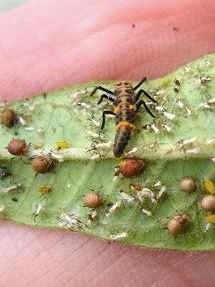Aphids' number one enemy is the ladybug. You recognize the adult, but do you know the adolescent larva? This is the one who empties the fridge!
Ladybug larva emerge black, then develop white/yellow/orange/red dots that become stripes that dominate the body as they grow and then pupate into their familiar adult form. Larval teenagers as well as adults can have different colour and dot patterns, depending on the type of ladybug and where it's from.
Babies? The eggs look like tiny rafts of whitish jellybeans attached to the underside of leaves. For the pupa stage, the larva attaches to the plant, to metamorph over seven to 10 days.
Aphids have plant preferences. Set these aphid-attracting plants at the rear of the bed where their ravaged state won't offend while you wait for the ladybugs to arrive.
In fall, let the plants to collapse on their own. The hollow stems provide overwintering shelter. Ladybugs usually overwinter communally, in crevices in rock walls, in cracks or in house nooks. Leaving shelter where they eat encourages them to stay in that nook in the garden and not in the house.
Editor’s note: This submission is part of a weekly series of online columns, which run every Tuesday, courtesy of the South Delta Garden Club.



